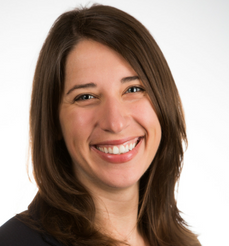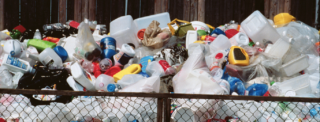- Resources
- Can the circular economy end the era of "Throwaway Living"?
Resources
Can the circular economy end the era of "Throwaway Living"?
Published: June 20, 2019 by Yesh Pavlik Slenk
In 1955, LIFE magazine ran an ad promoting “Throwaway Living,” encouraging the use of disposable items as a way to help cut down on household chores.
We used to depend on plastic, and now, our planet is being suffocated by it. Environmental impacts are showing the need for a more circular economy, and businesses are responding by offering innovation solutions, such as new products, packaging and business models, to address resource scarcity and climate risk not to mention unlock a $4.5 trillion economic opportunity.
I recently caught up with Brendan Edgerton, the Director of Circular Economy at the World Business Council for Sustainable Development (WBCSD), and EDF Climate Corps alum, about the progress being made toward circular models of design and production and his love of Swiss chocolate.
Circularity refers to shifting from current linear methods of production and consumption, where products are designed without consideration for what happens after use, to adopting circular models that keep products, components and materials within the economy.
How are companies innovating to address resource scarcity and climate risk?
We generally see three different phases for how companies incorporate circular innovation. The first is process innovation. How do companies improve their operations to become more resource efficient whether that’s in their water, energy or material consumption?
The second is product innovation. We need to examine the products that we’ve put out onto the market today, and figure out how we can improve them so that they are more circular. That could be through materials or design.
The last and most difficult phase is business-model innovation. This is where you start seeing products as a service being practiced, like the take-back schemes that enable consumers to return products or packaging after use. It requires a significant shift in how business is done, companies’ relationships with their customers, and how you work collaborate with your value chain. It’s challenging, but it’s where the really interesting innovation is. TerraCycle’s loop-project in partnership with P&G, Unilever and Nestle is a good example of this. They’re flipping the whole model of single use. And they’re designing packaging so it is more valuable.

What are some of the barriers for companies beginning to think about circularity?
One of the biggest challenges we see today is the general education and understanding of what circular economy is. It can be quite vague, and it’s not until you speak one-on-one with a company and do a deep dive into tangible strategies of the value chain that it becomes clear where their opportunities lie and what aspect of circular economy fits into their corporate strategy.
There are also challenges around policy and regulation. Policies were written for a certain time and with a certain economic assumption that everything will be harvested from the planet and will end up in landfills. A lot of these regulations, such as the definition of waste, differs from city to city. Being able to transfer products or byproducts after use might be challenging, particularly if you’re trying to carry it across a border of some sort.
Finally, there are financing challenges. Changes in business models means changes in accounting practices and how projects or initiatives are financed. Banks and equity investors are already looking into how they’ll need to change practices to accommodate a circular model.
How has momentum for circularity grown?
Companies are becoming more mature as far as what questions they’re asking and what they’re trying to do.
When I first started at WBCSD, we wouldn’t have been able to get five companies together to talk about circular economy, and if we did, the conversation would purely be around recycling owaste management. Fast forward to the beginning of last year when we launched Factor10, our flagship circular-economy program, we had over 30 companies committed, representing over $1.3 trillion in annual turnover. That momentum has continued to grow, and this year, we have 40 companies from 17 countries and 15 industries participating in Factor10.
Beyond that, we have over 60 global network partners that share our vision and mission. And they too, are increasingly developing programs around circular economy and sharing their insights that they’re capturing on a more local level.
Do you see a role for a common framework or a consensus around circularity?
It’s a balance. While it’d be great to have one common definition, that’s just not the case. It has to be material to the core strategy of each unique business – you can’t overprescribe and dictate what needs to be included. What’s important is ensuring that the core principles are there.
We’re striving for that balance now as we working with over two dozen companies in developing a common framework for measuring a company’s performance in the circular economy. The goal is to inform internal decision-making, and allow companies to understand the opportunities and risks that they have, based on how circular they are today.
What is your favorite thing about living in Switzerland?
The chocolate is fantastic, even the store-bought brand that you get for 50 cents. It’s probably one of the cheapest things you could buy here in Switzerland. It’s cliché, but it’s true. There are many things to appreciate about living in Switzerland, but that’s the first thing that came to mind. Says a lot, I guess.
This piece was originally published on GreenBiz.
Follow Yesh on Twitter
Follow EDF+Business on Twitter
